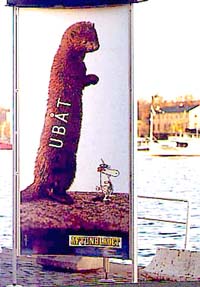
tabloid newspaper, poking
fun at results of the great
u-boat hunt ("UBÅT").
Not indicated is the role
of the Swedish press
in sustaining the
13-year hysteria.
From Neutrality
To NATO
(Pages 5-11)
A Cold Warrior's
Transfiguration
In 1981, a Soviet submarine-- running on the surface in full daylight-- stranded itself on some rocks off the coast of southern Sweden. This disquieting event, which gave palpable form to centuries of Russophobia, turned out to be the result of a disastrous navigation error. But it gave rise to an anxious wave of submarine "sightings", which always turned out to be something else.
In the absence of any clear evidence that the Soviets were intentionally violating Swedish sovereignty, the Palme government was reluctant to indict. But not the Conservative Party, and especially not its rising young turk, Carl Bildt. He interpreted Palme's restraint as a sign of weakness to the point of treason-- a word never uttered, but often implied.
For thirteen bootless years, the great submarine chase was kept alive by the cocksure fulminations of Carl Bildt and the customary irresponsibility of the mainstream press. It reached an embarrassing anti-climax in 1995, when the Swedish navy was compelled to acknowledge that the alarming sounds picked up by its hyper-sensitive recording devices were generated by unarmed minks and perhaps other natural phenomena, not Russian u-boats.
Nevertheless, the hysteria was sufficient to fuel right-wing paranoia for over thirteen years, and played a key role in whipping up the intense hatred aimed at Olof Palme during the final years of his life. Less than four months prior to his assassination, twelve naval officers signed their names to a debate article in Sweden's leading Conservative newspaper, Svenska Dagbladet, charging that Palme spoke with forked tongue on the submarine issue and neglected a serious threat to the nation's security. Therefore, they did not trust him, stated the article in black and white. A few months later, The New York Times concluded its obituary with a reference to that extraordinary naval manoeuvre.